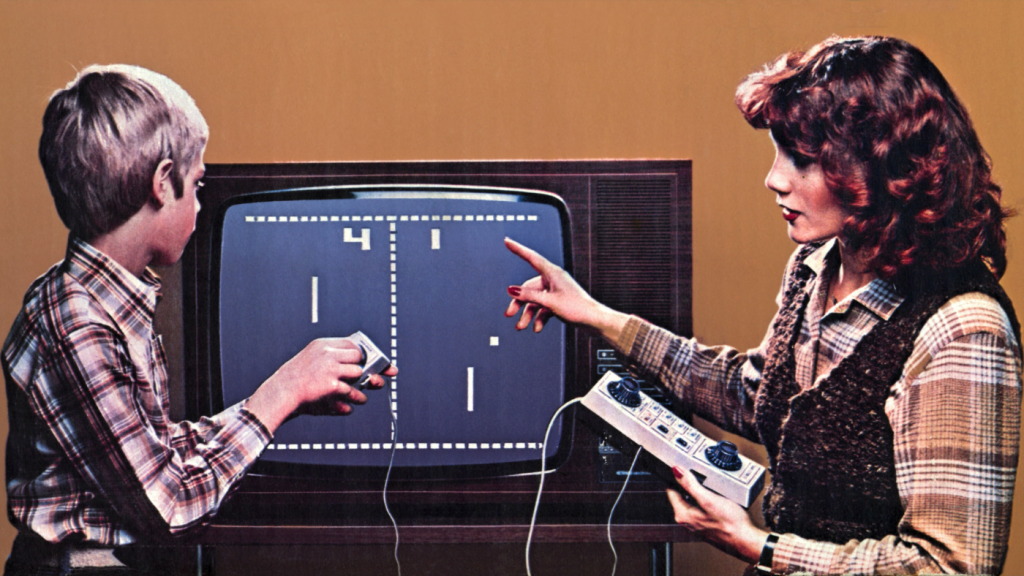< Back to All Articles on Classic 80’s Arcade Games

Released in 1972 by Atari, Pong is widely regarded as the first commercially successful arcade video game, and its influence on the gaming industry is profound. Created by Atari’s co-founder Nolan Bushnell and engineer Al Alcorn, Pong was a simple simulation of table tennis, where players controlled paddles to hit a ball back and forth across the screen. Despite its simplicity, Pong revolutionized the entertainment industry, laying the foundation for the video game boom that would follow. It became a cultural phenomenon and established video games as a mainstream form of entertainment.
One of the most significant ways Pong changed the gaming world was by introducing the concept of arcade gaming to the masses. Before Pong, video games were largely experimental and existed mostly in academic or research settings. However, Pong was the first game to capture the public’s imagination and bring video gaming into public spaces like bars, amusement parks, and bowling alleys. This accessibility was key to its success, as it allowed people who had never seen or played video games before to experience them for the first time. The arcade game format became the template for future game development and social gaming, setting the stage for the arcade culture that dominated the 1970s and 1980s.
Another way Pong changed the gaming world was through its commercial success. Prior to its release, video game development was a niche market, with few companies willing to invest in video game technology. Pong proved there was a demand for interactive entertainment, leading to a boom in arcade game production. It was such a success that it inspired countless clones and similar games, turning video game development into a legitimate industry. Atari, the company behind Pong, became one of the first video game giants, showing the world that video games could be profitable. This paved the way for other companies to invest in gaming hardware and software, eventually leading to the creation of home consoles and the development of the gaming industry as we know it today.
Moreover, Pong helped shape the direction of video game design and mechanics. The game’s simplicity—two paddles, a bouncing ball, and a score counter—was easy for players to grasp, making it accessible for people of all ages. Its design also highlighted key aspects of what would become the standard for future video games: interactivity, competition, and progression. While other early games like Spacewar! existed before Pong, it was Pong that showed that video games could be engaging and competitive, and most importantly, fun. The game’s competitive element, where two players could compete against each other in a head-to-head match, became a staple of future multiplayer games, solidifying the importance of player versus player (PvP) experiences in gaming.
Lastly, Pong’s success introduced the world to the idea of video games as a new form of entertainment. At the time of its release, television, movies, and traditional board games were the dominant forms of leisure activity. Pong changed the way people interacted with entertainment, providing an interactive experience that was both engaging and social. It also opened the door for the rise of gaming as an art form, where graphics, sound, and gameplay mechanics could evolve into sophisticated creations. In many ways, Pong was the spark that ignited a global industry, and its success showed that video games had the potential to be not only a popular pastime but also a cultural force that would shape the future of entertainment for generations to come.
In conclusion, Pong was more than just a game—it was a revolutionary moment in the history of entertainment. It brought video games into the public consciousness, sparked the growth of the video game industry, and set the stage for the incredible technological advancements that would follow. Its legacy continues to be felt today, as it remains a symbol of the humble beginnings of a global industry that now reaches billions of people worldwide. Without Pong, it’s hard to imagine how the video game world would have evolved, making it a cornerstone of gaming history.
Classic Arcade History Articles
• Arcade Popularity in the 1980s
• Arcade Popularity in the 1970s
• How Classic Arcade Games Were Made: Behind the Scenes of Iconic Titles
• Classic Arcade Characters: Icons of Gaming History
• Classic Arcade Music and Sounds: The Heartbeat of the Golden Age
• Most Popular Arcade Games of the 1980s: A Retrospective on an Iconic Era
• The Development of the NES: A Milestone in Gaming History
• The Popularity of Arcade Games in the 1980s: A Cultural Phenomenon
• How Classic Pong Changed the Gaming World
1980s Arcade Games and Gaming Console Articles
• The 1980s Gaming Console War: A Battle for Dominance
• The Best Action Nintendo Games from the 1980s
• The Best Sports Nintendo Games from the 1980s
• The Best SNES Games from the 1980s
• The Atari 2600: Revolutionizing Home Gaming
• ColecoVision: A Home Console Pioneer
• The Intellivision: A Challenger to Atari
• Classic Sega Games: Defining an Era
• ColecoVision: A Home Console Pioneer
• Atari 2600 vs Atari 5200 vs Atari 7800: A Comparative Look at Atari’s Iconic Consoles
Classic Gaming Emulator Articles
• Classic Arcade Emulators: Bringing Nostalgia to Modern Gaming
• Delta Emulator: Bringing Classic Gaming to Mobile Devices
• How Classic Arcade Emulators Work: Bringing Retro Games Back to Life
• About Our Online Video Game Emulators
Arcade Game Cheat Code Articles (Atari, Nintendo, Sega, ColecoVision)

